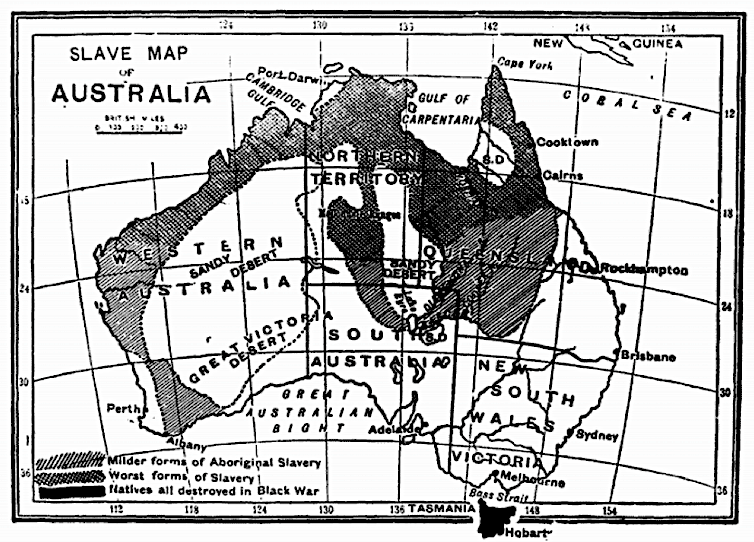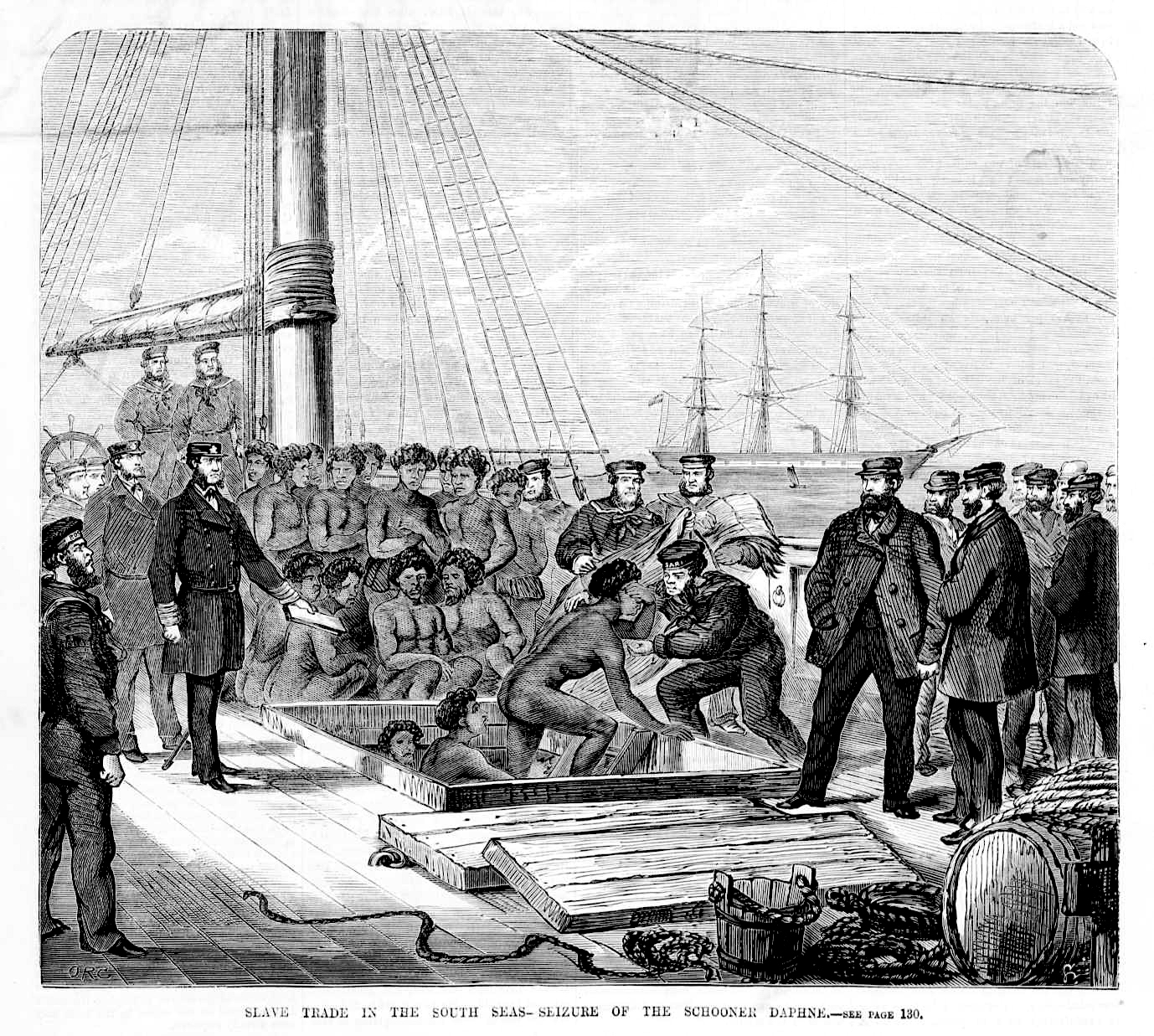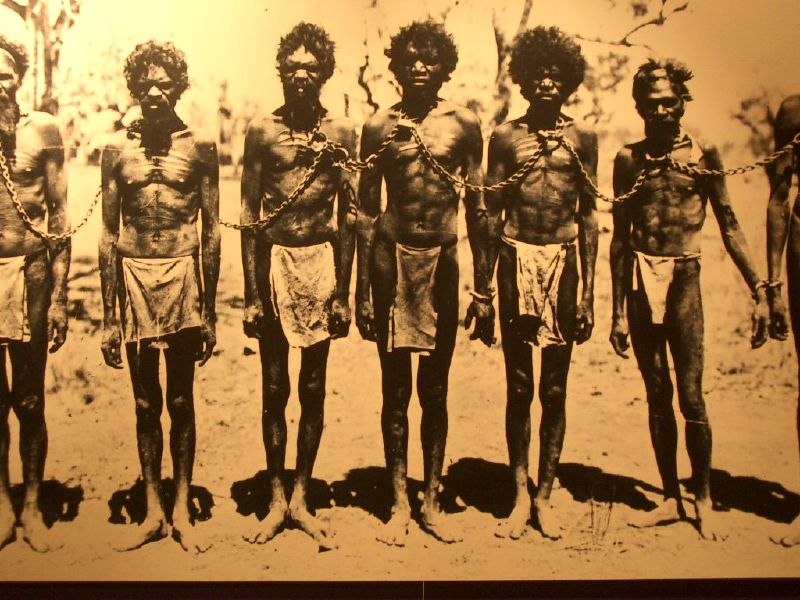Thalia Anthony and Stephen Gray show how the prime minister’s assertion is at odds with the historical record.

(Author provided)
By Thalia Anthony
University of Technology Sydney
and
Stephen Gray
Monash University

 Prime Minister Scott Morrison asserted in a radio interview that “there was no slavery in Australia.”
Prime Minister Scott Morrison asserted in a radio interview that “there was no slavery in Australia.”
This is a common misunderstanding which often obscures our nation’s history of exploitation of First Nations people and Pacific Islanders.
Morrison followed up with “I’ve always said we’ve got to be honest about our history”. Unfortunately, his statement is at odds with the historical record.
This history was widely and publicly documented, among other sources, in the 2006 Australian Senate report Unfinished Business: Indigenous Stolen Wages.
What is Slavery?
Australia was not a “slave state” like the American South. However, slavery is a broader concept. As Article 1 of the United Nations Slavery Convention says:
Slavery is the status or condition of a person over whom any or all of the powers attaching to the right of ownership are exercised.
These powers might include non-payment of wages, physical or sexual abuse, controls over freedom of movement, or selling a person like a piece of property. In the words of slavery historian Orlando Patterson, slavery is a form of “social death”.
Slavery has been illegal in the (former) British Empire since the Act for the Abolition of the Slave Trade of 1807, and certainly since 1833.
Slavery practices emerged in Australia in the 19th century and in some places endured until the 1950s.

“Governor Davey’s Proclamation” board, painted in 1830 and nailed to trees to depict a policy of friendliness and to show that colonists and Aboriginal people were equal before the law. (Government of Van Diemen’s Land, original conception by Surveyor General George Frankland, State Library of New South Wales, Wikimedia Commons)
Early Coverage of Slavery in AustraliaAs early as the 1860s, anti-slavery campaigners began to invoke “charges of chattel bondage and slavery” to describe north Australian conditions for Aboriginal labour.
In 1891 a “Slave Map of Modern Australia” was printed in the British Anti-Slavery Reporter, a journal that documented slavery around the world and campaigned against it.
Reprinted from English journalist Arthur Vogan’s account of frontier relations in Queensland, it showed large areas where:
… the traffic in Aboriginal labour, both children and adults, had descended into slavery conditions.
Seeds of Slavery in Australia

Seizure of the “blackbirding” schooner Daphne and its cargo by the HMS Rosario in 1869. (Samuel Calvert and Oswald Rose Campbell, National Library of Australia, Wikimedia Commons)
Some 62,000 Melanesian people were brought to Australia and enslaved to work in Queensland’s sugar plantations between 1863 and 1904. First Nations Australians had a more enduring experience of slavery, originally in the pearling industry in Western Australia and the Torres Strait and then in the cattle industry.
In the pastoral industry, employers exercised a high degree of control over “their” Aboriginal workers, who were bought and sold as chattels, particularly where they “went with” the property upon sale. There were restrictions on their freedom of choice and movement. There was cruel treatment and abuse, control of sexuality, and forced labour.
A stock worker at Meda Station in the Kimberley, Jimmy Bird, recalled:
… whitefellas would pull their gun out and kill any Aborigines who stood up to them. And there was none of this taking your time to pull up your boots either. No fear!
Aboriginal woman Ruby de Satge, who worked on a Queensland station, described the Queensland Protection Act as meaning:
if you are sitting down minding your own business, a station manager can come up to you and say, “I want a couple of blackfellows” … Just like picking up a cat or a dog.
Through their roles under the legislation, police, Aboriginal protectors and pastoral managers were complicit in this force.
Slavery was Sanctioned by Australian Law

Aboriginal slavery. (Nancy White, Flickr)
Legislation facilitated the enslavement of Aboriginal people across the Northern Territory, Western Australia, South Australia and Queensland. Under the South Australian Aborigines Act 1911, the government empowered police to “inspect workers and their conditions” but not to uphold basic working conditions or enforce payment. The Aboriginals Ordinance 1918 (Cth) allowed the forced recruitment of Indigenous workers in the Northern Territory, and legalised the non-payment of wages.
In Queensland, the licence system was effectively a blank cheque to recruit Aboriginal people into employment without their consent. Amendments to the Aboriginal Protection and Restriction of the Sale of Opium Act 1897 gave powers to the Protector or police officer to “expend” their wages or invest them in a trust fund – which was never paid out.
Officials were well aware that “slavery” was a public relations problem. The Chief Protector in the Northern Territory noted in 1927 that pastoral workers:
… are kept in a servitude that is nothing short of slavery.
In the early 1930s, Chief Protector Dr. Cecil Cook pointed out Australia was in breach of its obligations under the League of Nations Slavery Convention.
‘… it certainly exists here in its worst form’
Accusations of slavery continued into the 1930s, including through the British Commonwealth League.
In 1932 the North Australian Workers’ Union (NAWU) characterised Aboriginal workers as “slaves.” Unionist Owen Rowe argued:
If there is no slavery in the British Empire then the NT is not part of the British Empire; for it certainly exists here in its worst form.
In the 1940s, anthropologists Ronald and Catherine Berndt surveyed conditions on cattle stations owned by Lord Vestey, commenting that Aboriginal people:
… owned neither the huts in which they lived nor the land on which these were built, they had no rights of tenure, and in some cases have been sold or transferred with the property.
In 1958, counsel for the well-known Aboriginal artist Albert Namatjira argued that the Welfare Ordinance 1953 (Cth) was unconstitutional, because the enacting legislation was:
… a law for the enslavement of part of the population of the Northern Territory.
Profits from Slaves
Australia has unfinished business in repaying wages to Aboriginal and South Sea Islander slaves. First Nations slave work allowed big businesses to reap substantial profits, and helped maintain the Australian economy through the Great Depression. Aboriginal people are proud of their work on stations even though the historical narrative is enshrined in silence and denial.
As Bundjalung woman Valerie Linow has said of her experiences of slavery in the 1950s:
What if your wages got stolen? Honestly, wouldn’t you like to have your wages back? Honestly. I think it should be owed to the ones who were slave labour. We got up and worked from dawn to dusk … We lost everything – family, everything. You cannot go stealing our lousy little sixpence. We have got to have money back. You have got to give something back after all this country did to the Aboriginal people. You cannot keep stealing off us.
Thalia Anthony is professor of law at the University of Technology Sydney and Stephen Gray, Senior Lecturer, Faculty of Law, Monash University
This article is republished from The Conversation under a Creative Commons license. Read the original article.
Please Contribute to Consortium
News on its 25th Anniversary
Donate securely with  PayPal here.
PayPal here.
Or securely by credit card or check by clicking the red button:

I have no doubt that Scott Morrison’s words are being twisted to fit an agenda. Surely what he meant was that there was no licensed slave trade, which is correct. No one will disagree that the Aboriginals were treated appallingly. There was no feeling of brotherhood towards ‘savages’ or Catholics. Most of the latter were transported from Ireland and were widely treated as dangerous criminals even though most committed only minor offenses in their home country. The point I am making is that the British practiced a caste system and whilst your color marked you as a member of the out-group, it wasn’t a prerequisite.
The ignorance of Scott Morrison is what astounds me! – All this and much worse (the complete extinction of Tasmanian natives) was taught very clearly during my schooling in the 60s and early 70s.
That said, I believe “honesty about our past” and “compensation” are entirely separate issues.
Thank you for this enlightening and very sad, depressing piece. But not overly surprising, disgracefully. Is there no end to the racism of pale-skinned, low melanin people? No end to our eagerness to exploit, profit from and destroy the lives of indigenous peoples – and do so after we have *stolen* their lands???
In all honesty I had no idea at all about the indigenous of Australia being enslaved (along with other Pacific Island peoples), but it frankly does not surprise at all. Not at all. Greed and cruelty and a supremacist, inhumane, immoral mindset seem intrinsic to the vast majority of us with paleskins.
And equally as shocking – that this continued into the 1950s!!! Where was Brenda then??? Hmm?
As a low melanin, pale skinned person who has never owned any land, let alone stolen any, and who can point to three generations of activism towards easing the plight of the indigenous people of Australia among others from all the blighted populations of this world, I would invite you to consider the racism driving your emotional response to this article.
You also might like to further enlighten yourself with regard to the very sad history of slavery, exploitation and greed, by broadening the scope of your moral outrage to include the many centuries of slavery and the slave trade in particular throughout the African continent which preceded the arrival of Europeans, particularly the Indian ocean slave trade or Arab slave trade. You could also spare a moment to consider the plight of white convict settlers who were really no more than the surplus labourers from the downtrodden poor of the industrial revolution – 9 year old boys working 16 hours in coal pits hauling coal, the child labourers of the cotton mills, that sort of thing. Then you could take a look at the caste system which pre-existed British colonialism in India and which still exists in India today. The Chinese have a long tradition indentured labour, and, to be brutally honest, I don’t think the working conditions in some of the modern day factories in China which provide us with the endless supply of consumer garbage today are any less of a disgrace. And finally, I would urge you to have a really good look at the situation currently occurring in Palestine right now today while we all perusing utterly meaningless maps such as the one exhibited in the article above.
All of this is, as you say, extremely depressing, so why don’t you join us (including a great number of low-melanin type people) in keeping a cool head and a warm and courageous heart. Its what this world really needs right now